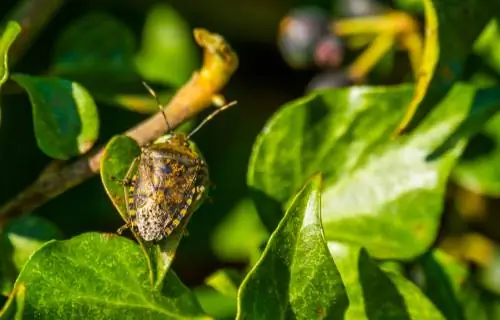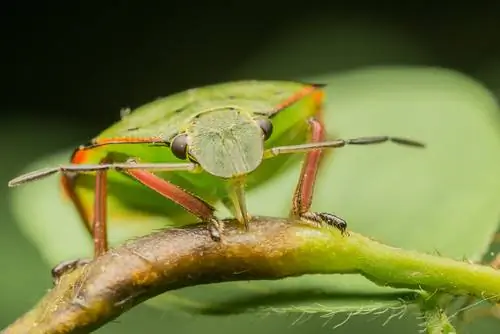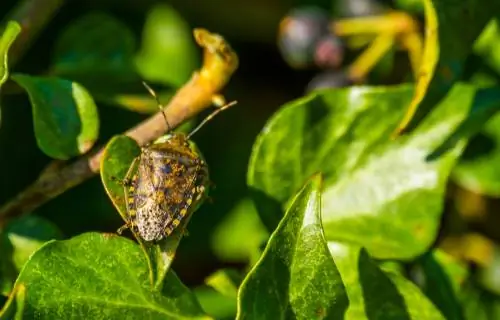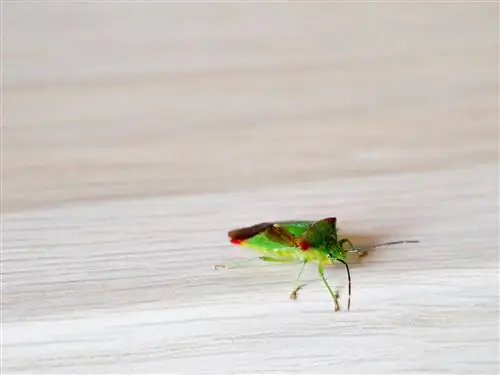- Author admin [email protected].
- Public 2023-12-26 14:17.
- Last modified 2025-01-23 11:22.
Misformed, inedible fruits and holed leaves: Some leaf bugs make life difficult for hobby gardeners. The pretty insects feed primarily on the plant or fruit juice of many crops and fruit plants, although the animals are not particularly picky. These measures help against an invasion in your home garden.

How to control and prevent leaf bugs in the garden?
Leaf bugs are insects that feed on plant juices, causing damage to leaves, shoots and fruit. They can be controlled with neem oil, paraffin oil or soapy water. Preventive measures such as regular collection, watering and mulching help to prevent infestation.
What are leaf bugs?
The term “leaf bugs” usually includes various species of soft bugs (Latin: Miridae), which in turn belong to the zoological order of the beaked bugs (Latin: Hemiptera). In contrast to other species of bugs, the animals, which are usually very beautifully drawn, usually feed on plant juices and pierce leaves and tender young shoots for this purpose. Juicy fruit - especially apples and berries - and sweet vegetables - such as peppers - are also very popular. Leaf bugs typically multiply particularly strongly in warm and dry temperatures, so that in some years they become real plagues.
Great biodiversity
Around 40,000 different species of bugs are known worldwide, but not all of them live on plant juices. Around 1,000 different leaf bug species are currently native to Germany, with the following six species being particularly common in gardens and orchards. Many other species are not relevant as garden pests.
| Art | Scientific name | Size | color | Occurrences | Period of occurrence | Food |
|---|---|---|---|---|---|---|
| Gray garden bug | Rhaphigaster nebulosa | 14 to 16 mm | Top inconspicuous gray, yellow & brown marbled | widespread, often in gardens and orchards, especially. a. on deciduous trees | all year round | Vegetable juices |
| Green Stink Bug | Palomena prasina | 10 to 14 mm | grass green with brown abdomen | in trees and bushes, primarily berry trees | May to November | Juices from berries and other fruits |
| Marbled Stink Bug | Halyomorpha halys | 13 to 18 mm | inconspicuous, brownish marbled upper surface, often with lighter spots | especially in the south of Germany, but is spreading increasingly | March to November | Plant and fruit juices |
| berry bug | Dolycoris baccarum | 10 to 12 mm | grey-brown base color, black and white pattern on the sides | widespread in meadows, gardens and bushes, often in blackberry hedges | June to November | Fruit juices, but also aphids and insect eggs |
| cabbage bug | Eurydema oleraceum | 6 to 8 mm | Basic color black-green with reddish, yellowish or white spots | Meadows, fields, bushes | March to October | Vegetable juices, v. a. of cruciferous plants |
| Common fire bug | Pyrrhocoris apterus | 9 to 12 mm | bright red with black spots | often on linden and mallow plants, but also on vines | all year round | mainly plant juices |
Excursus
New species immigrate to Germany
For several years now, more and more species of bugs have been immigrating to Germany from warmer climes, as they now also find ideal living conditions here due to climate change. The following article from SWR shows very well the consequences of this using the example of the Asian stink bug (also: marbled stink bug, Latin Halyomorpha halys):

Appearance
While the nymphs often do not look particularly similar to the adult leaf bugs in terms of color or pattern, fully developed bugs of all species have the following typical characteristics:
- Wings: usually clearly visible, but there are also short-winged and wingless varieties
- Top wing: usually very hardened and marked typical of the species
- Forewings: leathery in the front area, but skinny in the back area
- Chest area: clearly divided into three, each segment has a pair of legs
- Rostrum: no biting or chewing tools, but a multi-part proboscis called a “rostrum” in the head area
- Feeler: usually four-membered
The body shapes of the different types of bugs can be quite different: from rounded to elongated and narrow, practically everything occurs. The leaf bugs native here also differ greatly from one another in terms of their coloring and markings.
Lifestyle and reproduction

The appearance and color of bug eggs varies significantly depending on the type of bug
The females of many species of bugs have an ovipositor (the so-called ovipositor), with which they deposit the eggs in the soil or in soft plant parts after mating, depending on the species. The animals lay an average of 20 to 30 eggs, which are often grouped together as egg packets and are hardly visible. Some species even engage in brood care and guard eggs and young.
After hatching, the young animals, called nymphs, go through several developmental stages, at the end of which they always shed their skin. The nymphs do not pupate, but rather become more and more similar to the adults - which are called images - with each molt. Nymphs and images are often found at the same collection point. The adults overwinter in sheltered, warm places and lay their eggs the following spring.
Background
What types of bedbugs are found in the apartment?
Sheet bugs love the warmth and therefore frolic in the garden and on the fruit trees, especially during the summer months. When it finally gets cooler in autumn, the adult animals - the so-called images - look for a place to overwinter. They often get lost in apartments and, for example, like to hide in roller shutters and curtain boxes. If you find such an animal, do not catch it with your bare hands. Instead, let it crawl onto a piece of paper and then release it back into the garden.
Other types of bugs, on the other hand, feel very comfortable in an apartment all year round. These include blood-sucking species such as the house bug (Latin Cimex lectularius), also known as bed bugs, or predatory bugs such as the “masked hoodlum” (also: predatory or dust bug, Latin Reduvius personatus). These species can bite or sting and should therefore not be touched with unprotected hands.
What do leaf bugs eat?

Sheet bugs feed on plant juices
Most species of leaf bugs native here feed on sweet plant juices and for this purpose pierce the pathways on the leaves of various deciduous trees, but also of other useful and ornamental plants. They also often attack various types of fruit, including mainly soft fruits such as blackberries, raspberries and strawberries. Apples and pears as well as vegetable plants such as potatoes, beans, peppers and cabbage are also at risk. Most leaf bugs are not particular about their preferred food plants.
Occasionally, however, the winged insects also suck out other, usually dead, insects and (live) aphids. In addition, some species even enjoy the eggs of other insect species.
malicious image
Bedbugs, regardless of their type, become active when it is warm. When it gets cooler, they retreat into their hiding places.
A leaf bug infestation is easy to identify. The following characteristics indicate the pests:
- Pitting on leaves and young shoots
- brownish discolored puncture marks on leaves and stems
- Shoot tips, flowers and fruits wither away
- Buds don't open, flowers only half open
- torn leaf tissue
- inedible fruits
If the symptoms mentioned occur in warm to hot and dry weather, an infestation with leaf bugs is likely. The pungent smell reminiscent of coriander that emanates from the animals' stink glands is also characteristic. It's not just the so-called stink bugs that stink, but also all other types of bugs.
What can you do against a bedbug infestation?
The different types of bugs can all be controlled in the same way.
Shake off / collect
From early spring to autumn, the leaf bugs can be removed from the plants by shaking or collecting them. It is best to carry out this admittedly quite time-consuming (but gentler) procedure in the early hours of the morning when it is still cool and damp. Then the animals, still frozen from the night, are easy to catch.
Tip
Always wear gloves when collecting, as many types of bugs secrete smelly secretions in dangerous situations. The strong, unpleasant smell remains on the skin for a long time.
Cumshot with soapy water

Many pests can be repelled with soapy water
An effective remedy not only against leaf bugs, but also against many other pests is homemade soapy water. Prepare these as follows:
- Buy a liquid soft soap without any additives.
- You can also purchase solid soft soap and grate it.
- Mix 80 milliliters of soft soap with 100 milliliters of warm water.
- If necessary, dissolve the soap in the water.
- Add a splash of mineral spirits to the mixture to increase effectiveness.
- Spray the leaf bugs several times a day.
But be careful: many ornamental plants with delicate, soft leaves do not tolerate soapy water. You should also avoid treating salads, leafy vegetables and other plants intended for consumption with it.
Spraying with neem oil
Neem oil, which is obtained from the fruits of the Indian neem tree, is also an effective remedy against leaf bugs and other pests. If you spray the affected plants with the agent every few days, the adults as well as their larvae and eggs will die. However, neem should only be used if there is a very severe infestation, because although it is plant-based, it is a strong insecticide that also has a negative effect on other beneficial insects and other animal species.
Paraffin oil against leaf bugs
The same applies to paraffin oil, which is also very effective and kills not only leaf bugs, but also ladybirds and other beneficial insects by suffocating them. In addition, this product is not suitable for crops as they can no longer be consumed.
Which insecticides help against leaf bugs?
Chemical insecticides should only be used in an emergency and when nothing else works. These agents cause lasting damage to flora and fauna and should be avoided, especially in vegetable and orchards. If necessary, use sprays containing the active ingredient thiacloprid, as this is comparatively harmless to bees.
Effectively prevent leaf bugs
Preventative measures are immensely important in order to counteract a pest infestation from the outset. The following approaches are suitable for containing leaf bugs:
- Collect and dispose of images regularly in spring.
- This means the animals can no longer reproduce.
- For the same reason, carry out regular checks, especially during hot and dry weather.
- Water and mulch plants regularly. An evenly moist soil keeps leaf bugs away.
- Weed the beds regularly and remove weeds.
- If beneficial insects such as birds and toads settle in the garden, offer them nesting places and shelter.
Frequently asked questions
Are leaf bugs dangerous?
Sheet bugs are not dangerous to humans or pets.
Can leaf bugs bite?
As a rule, leaf bugs do not sting or bite, after all, humans are not part of their natural diet. When threatened, the insects instead secrete a smelly secretion, the smell of which is difficult to remove from skin, hair and objects.
Are fire bugs poisonous to dogs?
Fire bugs and other common leaf bug species are not poisonous to pets or people. This also applies to the smelly secretion, which is unpleasant but completely harmless.
What predators do leaf bugs have?
If you want to keep the bug infestation in your garden to a minimum, you should make songbirds and smaller, insect-eating animals (e.g. toads) comfortable. These animals feed on leaf bugs and other pests. In addition, predatory bugs (Latin: Reduviidae) also like to eat their leaf sap-sucking relatives, but can spread diseases such as Chagas disease.
Tip
A close-meshed insect net that you spread over fruit and berry trees also keeps the bug population in check. But be careful: sometimes songbirds get caught in these nets and can no longer free themselves.






